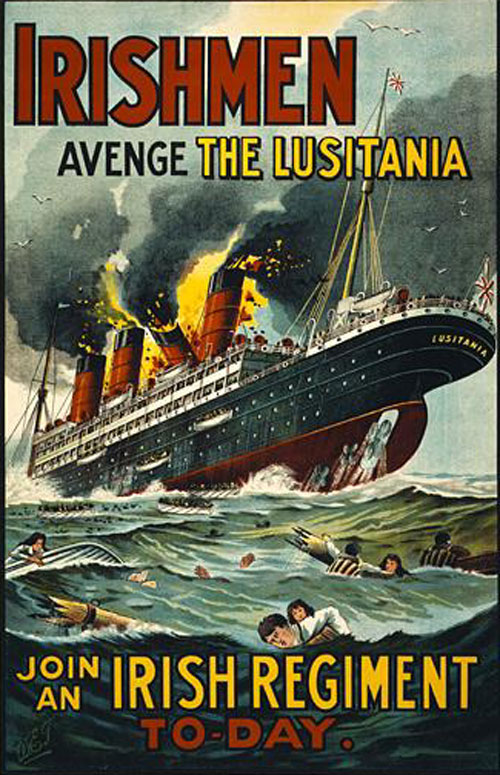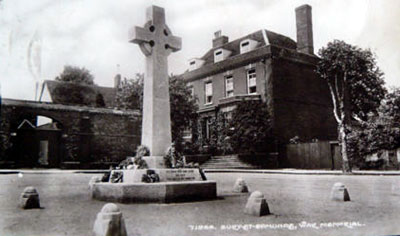
In 1914 the Commanders of the British Army were the celebrities of the day, often known for their earlier exploits in the Boer War or in India. Sir John French was placed in command of the British Expeditionary Force that crossed into France to halt the German advance. My father was born in December, 1914, and was named after the famous Field Marshall, John French Addy. These postcards celebrated the men leading the war effort.
|

General Horace Smith-Dorrien was commander of II corps of the BEF, and reported to French. My father's twin brother was named after Smith-Dorrien, and was given the name Horace Dorrien Addy. This illustrates the regard with which the public held the High Command at the start of the war. This card was posted in July, 1915, and the action referred to above was the battle at Le Cateau covering the retreat from Mons in August, 1914.
|

The world reacted in disbelief when, on May 7th 1915 a German U-boat attacked the Lusitania, a British passenger liner that was traveling from New York to Liverpool. Nearly 1,200 persons were killed, including 128 Americans. Germany defended the sinking of the Lusitania by correctly asserting that the ship was transporting a large supply of small-arms ammunition. This fact did little to convince Americans that Germany was justified.
The loss of the Lusitania was quickly used as a recruitment poster. |

In Germany the sinking was regarded as a major success for the U-Boats and Germany's war effort. In August of 1915, several months after the sinking of the Lusitania, Karl Goetz produced his first version of the bronze Lusitania medal. Showing an incorrect date the error was picked up by the British as a propaganda bonanza, and Goetz later produced a variety with the correct date. This view shows Lusitania slipping beneath the waves stern first (opposite to what really happened) and with obvious war contraband on her deck: cannon, war planes, armaments, with the admonishment above "No Contraband Goods!" Below is the German equivalent of, "The liner Lusitania sunk by a German submarine May 5, 1915."
|

The Reverse of the medal shows a skeleton (representing death) selling passage tickets at the Cunard Line office. Along the top of the medal are the German words for "Business Above All" mocking the Cunard Line for willingly placing passenger's lives at stake. At left is a man reading a paper on which are the German words for "U-Boat danger", while behind him is the figure of the German ambassador, Count Johann-Heinrich von Bernstorff, raising a wagging finger as a reminder that the Germans had placed a warning advertisement in the same newspaper as the Cunard Lines sailing schedule. |

British Intelligence copied the German Lusitania medallion and advertised it around the world to show the barbarian nature of the Germans. Some 300,000 British copies of the medallion were made, in iron, on the instructions of Captain Reginald Hall R.N., the Director of Naval Intelligence. The British replicas were sold for 1 pound each, with the proceeds going to St. Dunstan's Blinded Soldiers and Sailors Hostels and the Red Cross, in special boxes with a view of R. M. S. Lusitania on the outside. A label on the box holding the medal read:
"The "Lusitania" (German) Medal. An exact replica of the medal which was designed in Germany and distributed to commemorate the sinking of the "Lusitania." This indicates the true feeling the War Lords endeavour to stimulate, and is proof positive that such crimes are not merely regarded favourably, but are given every encouragement in the land of Kultur. The "Lusitania" was sunk by a German submarine on May 7, 1915. She had on board at that time 1,951 passengers and crew, of whom 1,198 perished."
|

One result of the anti-German propaganda was a nationwide attack on premises run by persons thought to be German. In West Suffolk the Bury Free Press ran a series of anti-German articles, with veiled references to a supposedly pro-German local innkeeper. The landlord of the Griffin on the corner of Cornhill and Brentgovel Street was called Theodore Jacobus. The Griffin was attacked by locally billetted Royal Engineers on 15th May, 1915, following these articles. Jacobus even put up a notice to say that he was a British citizen, but this was ignored. Bricks were thrown through all the windows and the mob only dispersed after a long struggle.
|

After the Zeppelin raid on Bury St Edmunds on April 30th, 1915, Johnsons the Dyers and Dry Cleaners quickly advertised that they were still open for business.
|

In 1907, Edith Cavell, from Norfolk, had been appointed Matron of the Berkendael Medical Institute in Brussels which she transformed into a teaching hospital of some excellence.
After the outbreak of war in 1914, the hospital came under the auspices of the Red Cross, but in German hands. Cavell and her staff aided the sick and wounded but she also gave sanctuary to escaping Allied soldiers. In August 1915, Cavell was arrested by the Germans for "harbouring aliens and helping them to escape". In due course she was sentenced to death, and despite efforts to save her by neutral diplomats, at dawn on 12th October 1915, she was shot by a firing squad. This postcard highlighted her death and was used to rouse the spirit of vengeance. After the war her body was returned to Norfolk and buried by Norwich Cathedral.
|

Propaganda was not always well received at the Front, where black humour became the British Army outlet for disillusion and constant stress. Captain Bruce Bairnsfather's cartoons were widely published, first in the Bystander and later in Fragments from the Front. Bruce Bairnsfather was an officer in the Royal Warwickshire Regiment who arrived in France in 1914. He created a cartoon character called "Old Bill", who with his blob nose, walrus moustache, muffler and balaclava (later it was replaced by a tin helmet) made Bairnsfather a household name. Later the cartoons were issued as postcards.
|

Dated 1 January 1917 - Guidance to the civil population of East Suffolk in the event of a landing by the enemy on the coast. The leaflet outlines the procedures and action to be taken (such as destroying all forms of transport and fuel) during the possible States of Emergency: standby; as you were; partial; or total. It reminds the public that 'defeat of the enemy depends on their own hearty co-operation'.
|

"The Irresistible Tanks" was a postcard published by the National War Savings Committee's War Bonds Campaign. The reverse has slogans like, 'Feed the Guns with War Bonds', and 'Passed by the censor'. Sold for 1d, the material was supplied by the Ministry of Information.
|

Nothing cheered civilians more than seeing the feared Zeppelin airships attacked, and preferably shot down. However it was late into 1916 before British defences started to take a toll of airships. By 1917 the Zeppelin raids had diminished because of this. This is Zeppelin L48, shot down on 17th June, 1917 at Holly Tree farm, near Theberton in East Suffolk, by a Home Defence BE12 aircraft. There were only 3 survivors, with 14 deaths. It was the only Zeppelin to crash land in Suffolk. A few landed in other counties and some were lost to the sea.
|

Displaying captured weaponry was widely used to boost morale for both troops and civilians. These three German guns were placed in the park at Bury St Edmunds, Suffolk. Dated only roughly to 1914-1918.
This Photograph bears a note of two names, "Hall", "Lait" and 1 unidentified soldier with a civilian in the Abbey gardens.
|

Clearly this gun was captured on 1st March, 1917. It may be one of the three guns previously seen in the park.
|

This photograph is "In the park". It shows a view through one of the abbey ruin arches of an obsolete British tank with two soldiers standing between its tracks.
|

Souvenir of the Zeppelin attack on Bury St Edmunds. This porcelain piece is about an inch tall, and many surviving pieces have lost the "handle".
(Martyn Taylor collection)
|

View of the base of the Goss bomb design souvenir, describing the Zeppelin attack. The piece was re-used for many other towns with their own coat of arms and name, of course. However, the base always carried this inscription.
(Martyn Taylor collection)
|


